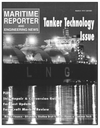
Page 64: of Maritime Reporter Magazine (March 1997)
Read this page in Pdf, Flash or Html5 edition of March 1997 Maritime Reporter Magazine
FEROX
Combustion Managers
FEROX TREATED FUEL
REDUCES
POLLUTION
MAINTENANCE
FUEL CONSUMPTION
AND ELIMINATES FUEL ALGAE
For more information concerning these products please call, write or fax....
H#TEK
A Combustion Company 126 South 5* Street . Leesburg, Florida 34748
Tel/Fax (352) 323-0988
ToU Free 1-800-715-8417
Redland
Circle 306 on Reader Service Card
Circle 307 on Reader Service Card Circle 233 on Reader Service Card
Pound For Pound,
Ballast-Crete Is Better.
For All Marine Fixed Ballast Operations
Densities Up To 400 pcf (S.G. 6.4)
Inorganic, removable, and available in a wide range of densities, Ballast-
Crete is the ballast of choice for naval architects and engineers around the world. For more information, call
Redland Genstarat (410) 682-5985. "State-Of-The-Art"
Non-Slip Safety Flooring
Unusual Sailing
Companions: Felix the CAT, a 269-ft. (82-m) vehicle-passenger cata- maran built by Austal
Ships, sails with the
Endeavor replica sailing ship. Felix was built for the partnership of
SweFerry and DS0.
For further information please call toll-free: 1 -888-SLIPNOT
U.S. Patent No.s 4961973, 5077137
S/zpHOT
V SAFETY FLOORING
SlipNot Safety Flooring Division
W.S. Molnar Company 2545 Beaufait Street, Detroit, Ml 48207 (313) 923-0400 Fax (313) 923-4555
SlipNot® Safety
Flooring is available in plate and grate form, in steel on steel, steel on alu- minum, and stain- less on stainless. In a patented process, hard Martensitic al- loys are applied to the product so sharp faces are continually exposed as the sur- face slowly wears.
SlipNot Products are designed for new installation or retrofit
Depth and coarse- ness may be varied.
SlipNot Safety
Flooring is used by many Fortune 500 companies to ensure safety in the work- place. It replaces or covers old technolo- gy such as diamond and checkered plate and grating which becomes dangerous when worn or wet.
Harbour Intermodal Seeks Capital For
Fast Harbor Transport Service
Harbour Intermodal believes it has the blue- prints for a fast harbor transportation service that, following its successful implementation in the
Greater New York Harbor area, would be applica- ble and marketable in most any port around the world. Specifically, the company has devised a feeder transportation service which incorporates a new vessel design with electronically controlled floating slips, designed to speed cargo on its way in busy ports.
The company has invested time and money in studying the means needed to meet changing freight transportation needs. Specifically, it has developed a plan — around a vessel dubbed the
HILX 404 Intermodal Ferry — calling for a net- work of waterborne intermodal ferry services link- ing major railroad and trucking terminals in the
Greater New York Harbor area. Intermodal ferry service across the New York Harbor would initially run between a terminal in New Jersey and one in
Bay Ridge, Brooklyn. Other terminals would be added in New Jersey, Brooklyn, Queens and the
Bronx.
New Vessel Design
The HILX 404 Intermodal Ferry, the backbone of
Harbour Intermodal's proposed shuttle/ferry ser- vice, offers speed and versatility. The 404-ft. (123- m) vessel was designed by a Finnish company as a double-ended, self-propelled, shallow-draft craft.
It will reportedly be able to be loaded and unloaded in 15 to 30 minutes.
Propelled by Aquamaster 360-degree rotatable propulsion units at both ends, the HILX 404 is designed to transport a combination of railway cars, trailers, containers and special freight, with a capacity of 25 to 30 railway cars or five articulated five-section twin-stack railway container cars and five parallel trucks. It can also carry up to 50 over- the-road trailers, and 100 to 150 fully loaded con- tainers. While the company's "testbed" is New
York, it is important to note that the system is designed for feeder services between major ports and smaller ports which cannot accommodate deep-draft oceangoing vessels, or those which do not have the volume of freight to justify service by a larger ship. The company plans to build and prove the system in New York, then market it around the world.
Finnyards Develops New Series Of High
Speed Vessels
Finnyards has developed a complete series of both high-speed monohull and multihull vessels to cover the speed range between 25 to 40 knots, with a carrying capacity from 600 to 1,500 passengers and 160 to 350 cars, respectively.
Finnyards has considerable experience in the high-speed vessel segment, having recently deliv- ered the innovative GTS Stena Explorer and Stena
Voyager, the world's largest aluminum catama- rans.
For more information from Finnyards
Circle 83 on Reader Service Card
Maritime Reporter/Engineering News

 63
63

 65
65
